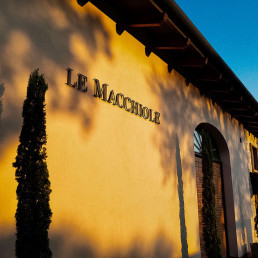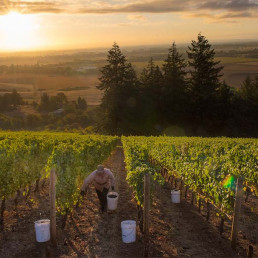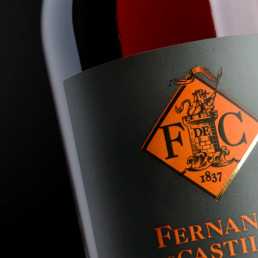D&N Wondermakers: Hyde de Villaine
Pedigree par Excellence
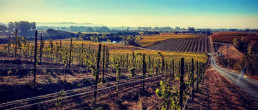
We’ve heard the saying: “it’s a marriage made in heaven”, well, in the case of this month’s Dhall & Nash Wondermaker, Hyde de Villaine, this is indeed a marriage made in a wondrous vinous heaven between two winemaking royal families. Two pedigrees par excellence! The families’ winemaking histories collectively span four centuries fusing together generations of mastery and knowledge with some of the most coveted fruit in Napa Valley to produce singular, world-class wines.
“[The HdV] venture has all the makings of a success story, with a can’t-miss cast of characters.”
Wine Spectator
Hyde de Villaine is an inspired power venture between two visionaries from two cultures on two continents – the Hyde Family of Napa and the de Villaine Family co-owners of the legendary Domaine de la Romanée-Conti in Burgundy. These first families of wine were in fact, brought together by another star-crossed marriage, that of Pamela (née Fairbanks) first cousin of Larry Hyde to Aubert de Villaine, of famed DRC.
From the very first vintage in 2000, Hyde de Villaine (HdV) wines have shown their pedigree, merging the finesse and balance of Old-World winemaking with the exuberance of California fruit from the renowned Hyde Vineyard.
“The letters DRC are magical in the wine world. It just so happens that they rhyme with HdV.”
Wine Spectator
Aubert de Villaine brings the rich traditions of France’s winemaking techniques, driving Hyde de Villaine’s viticulture and winemaking philosophy — one that embraces minimal intervention by the winemaker in order to express the varietal, the vineyard, and the vintage. Larry Hyde brings a legacy of family farming in California and over four decades of experience growing premium wine grapes in Napa Valley, particularly Carneros. Aubert and Larry are both innovators with a desire for continuous improvement in the vineyard, and they have established a culture around the pursuit of excellence for Hyde de Villaine wines over the past 2 decades.
“This was never your typical vanity project, but I suppose in some respects it is, but the point was that they were always doing this for the right reasons – making wine that speaks of the place… not Châteaux Cash Flow”
explains HdV General Manager James Eyer
The History
Perfect Pedigree on Both Sides
There is such an unmistakable sense of history within this winery. Starting with DRC ad it’s wines, they are the elite. Its Le Montrachet is perhaps the most famous white wine in the world. DRC’s grands crus reds, including Romanée-Conti and La Tâche, are renowned for their distinctive styles. Moreover, de Villaine is a shrewd businessman but also a creative, overseeing the minutest details of his coveted wines.
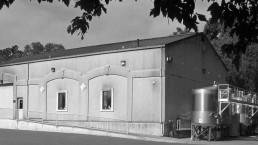
Aubert de Villaine
Decanter's Man of the Year 2010
Accordingly, he is involved in virtually all the details with HdV. He visits the vineyard frequently, talks by phone with his staff in California almost daily, and pays close attention to grape growing and winemaking techniques. He is always involved in the hiring of the French winemakers.
The other visionary and De Villaine’s principal partner is Larry Hyde, a grape grower extraordinaire. Larry knows his land and his vines. His family’s wine roots in California go back more than a century – his and Pamela’s ancestors, the de la Guerra family, is one of the oldest winemaking families in California and traces its winemaking history back to a gold medal received at the 1876 Philadelphia Centennial Fair.
Fittingly, the HdV label bears the de la Guerra coat of arms. The partnership feels that this coat of arms symbolizes the sense of tradition, family, and winemaking history that their venture embodies in its philosophy.
Although every wine geek knows everything about Aubert, Larry has been a quiet over-achiever. Larry’s first wine job was working in the vineyards at Ridge Vineyards in 1970. Later he worked in the winery at Joseph Phelps. With both vineyard and winemaking experience under this belt, he started Hyde Vineyard in Carneros in 1979 after his father Richard purchased their initial land. The ranch has since expanded to nearly 200 planted acres spanning both sides of Highway 12 – all in the Napa side of Carneros. Larry has kept a few select blocks back for himself and HdV. After years of being a grower of exceptional fruit, it took the masterful persuasion of his cousin Pamela and her husband Aubert to convince Larry it was time to make their own wines.
“Because of his ‘other’ project he’s [Aubert de Villaine] never been interested in making DRC West”
James Eyer, General Manager at HdV
The Craftsmen
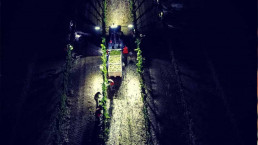
The expressiveness of the wines is down to the terroir and the skill of the five-strong Franco-American winemaking team with Aubert de Villaine overseeing as Director of Winemaking. Ultimately, Aubert is very hands-on in the running of HdV – “There is nothing he doesn’t influence,” says GM James Eyer.
There have been a few winemaker changes along the way: Jean-Laurent Vacheron at the beginning, gave way to Stéphane Vivier, who then gave way to Guillaume Boudet in 2013. Boudet is a Bordeaux native whose grandfather was a barrel maker. He worked a harvest at Château Haut-Brion, studied with the late, great Denis Dubourdieu, and then found his way to the Russian River Valley before connecting with HdV.
Boudet works side by side with the estate’s General Manager, James Eyer. A Californian, Eyer caught the wine bug after finishing college, so he turned around and went back to get an MBA so he could focus on the business side of the wine industry. The pair gives the project a hands-on, French-American one-two punch in line with its founders.
The San Francisco Chronicle dubbed Hyde de Villaine as “the King of the Carneros.“
The Terroir
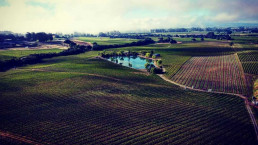
For HdV, that unique patch of dirt, of famed terroir, is the one and only Hyde Vineyard. Marked by a tiny sign along Highway 121 that connects Napa to Sonoma, the vineyard is just a few kilometres north of the cold-water influence of San Pablo Bay. On the Napa Valley side of Carneros, the long, gently rolling piece of land is planted mostly to Chardonnay and Pinot Noir with small pockets of Syrah, Cabernet and Merlot.
The original plantings of 1979 Wente clone Chardonnay and 1986 Calera clone Pinot Noir are still going strong, along with newer plantings, producing some of the most coveted grapes in Napa Valley.
Covering sedimentary terraces, Hyde Vineyard is blessed with shallow loamy soils and ancient streambeds that work in conjunction with the cool Carneros climate and gentle winds to create moderate hydric stress which encourages the vines to maximize their potential. The temperature moderating winds off the Pacific Ocean, which are channelled through the Petaluma Gap, are key in allowing for prolonged growing seasons. This extended growing season is vital to the completion of phenolic maturation, bringing both intensity and balance to the wines. The benchmark of any top drop.
“Hyde Vineyard can’t touch the pedigree of DRC, but its reputation has been on the rise this past decade due to Hyde’s diligence.”
Wine Spectator
Philosophy
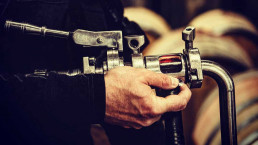
The winemaking approach has what could easily be interpreted as a Burgundian philosophy or California with restraint and discipline. The end result are wines that are not made to a cookie-cutter style but vary vintage by vintage, and are characterised by a fresh, focused minerality.
The foundation of HdV’s philosophy is that the best and most respectful winemaking is done in the vineyard prior to harvest. A range of biodynamic, organic, and sustainable practices are used in the vineyard to ensure its viability for generations to come.
Right from the start, Hyde Vineyard has gained distinction for its single vineyard wines. Extending this single vineyard approach, the HdV team endeavour to bring transparency to the unique expression of the Hyde Vineyards’ terroir. Their winemaking team spends countless hours working year-round with the vines to ensure that only the best quality fruit arrives at the winery. Once harvested, the team becomes caretakers of the wine, never adhering to a style or recipe, but reacting to the characteristics of each vintage and block to ensure the true expression of the vineyard sings through the wines.
“[] it is our belief that an unadulterated expression of exceptional terroir is what separates good wines from truly great wines.”
(HdV website)
Amongst the Vines
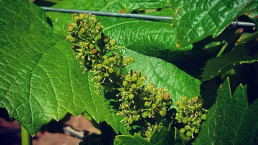
Only nineteen of Hyde’s 156 acres are used for HdV wines with the winery given first right of refusal of the best vineyard sites when it launched in 2000. The rest of the vineyards grow premium fruit for a who’s who of top Napa wineries including Kistler, Patz & Hall, Ramey, DuMOL and Schramsberg to name just a few of the clients they have with 35-40 more on the waiting list.
Within the iconic Hyde Vineyard itself, the vines tend to have minimal soil compaction, resulting in a healthy microbial ecosystem and a naturally balanced substructure for the vines. Sustainably and organically farmed, their vines flourish under a naturally balanced environment that allows a certain amount of vine disease to occur. Though seemingly counterintuitive, the great producers of France have long understood that a certain amount of disease is not only natural but aids in stressing the vine into producing its finest wines. By avoiding chemical fertilizers and herbicides, a condition of biodiversity in the soil allows the vines to naturally repel most disease through the presence of beneficial organisms and bacteria.
“[the HdV wines] are classy and understated, almost more French in their refinement and texture than classically Californian, a style which tends to be riper, richer, and often oakier. They are not, however, anything like DRC’s wines, nor should they be compared. Carneros is not Vosne-Romanée or the Côte de Nuits.”
James Laube, Wine Spectator
So how involved is Aubert in the running of HdV you might ask? “There is nothing he doesn’t influence,” says GM James Eyer. Without a doubt, Aubert de Villaine always wanted to maintain a thread of Burgundian ideology in HdV’s winemaking and viticulture.
In the Winery
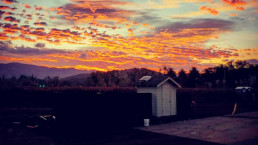
The winery was designed and developed to accommodate every aspect of HdV’s winemaking philosophy of minimal intervention. HdV strongly believes in the gentlest handling of the grapes and minimal intervention in order to let the wines develop the characteristics that are true to the vineyard terroir.
The fruit goes through meticulous sorting: on the vine, at the picking bin and at the winery on a state-of-the-art sorting table. HdV’s equipment is custom designed to maximize the use of gravity and minimize the exposure to mechanical pumping. The juice is taken to an assortment of tanks from stainless steel to wooden vats or oak barrels. The ability to utilize multiple tank types allows Hyde de Villaine the flexibility to express the distinctive characteristics of each block.
Every barrel or vat is then followed by Boudet personally until it is time to make the final blend. Only the finest barrels of wine make it to the bottle. Commitment exemplified.
“From inception, Hyde de Villaine has had one mandate, create wines that capture the true essence of the vineyard and deliver it to the glass…no exceptions.”
(HdV website)
The Hyde de Villaine Beauties
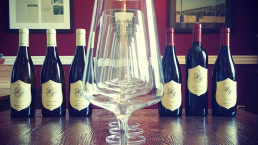
The Hyde de Villaine (HdV) Chardonnay is distinctive from its Californian counterparts for its minerality, structure and natural acidity, all of which provide a fresh, seamless wine that pairs beautifully with food.
All of the Hyde de Villaine’s wines combine a degree of the finesse, elegance, and refinement, which most of us would associate with European wines, with a balance of richness and vitality bolstered by the relatively cool, breezy climate of the Carneros subregion.
HdV produce two Chardonnays (the HdV and the de la Guerra) – one from 30+ year old vines and one, the De la Guerra, from younger vines. Both of these chardonnays positively shimmer with energy!
Throw out any preconceived notions you might have about malolactic fermentation in regard to Chardonnay when you try these. These wines undergo 100% secondary fermentation with neutral bacteria but are wines that are not characterized by the usual components when discussing malolactic fermentation (that is, buttery, creamy, viscous etc). Their Chardonnays are rather crisp as the acidity plays a big part in this. And the reason their wines undergo full malolactic fermentation is prior to this secondary fermentation, their Chardonnay is so high in acid it has been described as being somewhat sharp on the palate. The finished Chardonnay wines are impeccably balanced, vibrant, and utterly compelling.
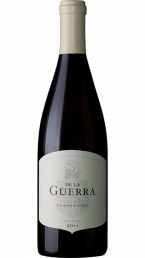
Hyde de Villaine "De la Guerra" Chardonnay 2017
The Hyde de Villaine De la Guerra Chardonnay is sourced each vintage from a young vine block of the Calera clone chardonnay. The wine is bright and energetic, with a distinctly mineral nose of crushed stone entwined with apple blossom, citrus zest, and fresh almond. The palate is focused with flavours of ripe pear, peach, lemon curd and the hallmark minerality of the Hyde Vineyard.
94 points “Powerfully structured, with ripe citrus accents to the fresh white fruit and spice flavors, supported by ample acidity. Hints of tropical fruit emerge midpalate, leading to a finish that shows savory richness. Best from 2022 through 2027. 1,561 cases made.”
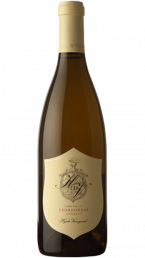
Hyde de Villaine Chardonnay 2018
The HdV Hyde Chardonnay is aged in French oak (20 percent new) for 12 months, followed by three months in stainless steel and an additional 14 months of bottle maturation. Reminiscent of grand cru Burgundy, this wine will age gracefully for two decades.
98 points Opulent aromas of cooked apple, lemon rind, light praline, and stone. Full-bodied with linear and lively acidity that runs through the wine. Energetic and bright with tightness and structure. Steely. Drinkable now, but better in 2023.
98 points – James Suckling
93 points Elegantly fruity, with tropical nuances to the rich white fruit and spice flavors that are well-structured. Tangerine hints mid palate lead to a spicy finish that offers brioche accents.
93 points – Wine Spectator
95 points The 2018 Chardonnay is powerful and hedonistic, with a touch less aromatic purity than its excellent 2019 counterpart. It opens with flinty aromas that segue to white peaches, baked apples, beeswax, roasted almonds, and baking spices. The medium-bodied palate is textural and concentrated with flinty accents and rounded acidity, finishing with lots of savory layers and a compelling hint of dried sage. 9
95 points – Robert Parker’s Wine Advocate
The Hyde de Villaine Reds
“[] with tremendous presence, the Ygnacia is a real charmer. Readers will have a very hard time keeping their hands off this jewel of a wine.”
Antonio Galloni, Vinous
There is a captivating back story behind the HdV Pinot Noir – It took a long time for Aubert to be satisfied with the site. The first vintage of Pinot Noir by HdV was the 2012 Ysabel, though that was made from grapes sourced from Van der Kamp Vineyards on Sonoma Mountain and the bottling was eventually discontinued when their Hyde fruit came on.
In the intervening years, Aubert and Larry carefully studied and selected the right site and the clones that now make the Ygnacia Pinot. Planted on an optimal location in the Hyde Vineyard, the Pinot Noir is a blend of 7 heritage clones collected by Larry Hyde over 40 years. This wine represents a lifetime of work by Larry in his pursuit of the finest Pinot Noir clones in the New World. And obviously this was never going to be just any old pinot being bottled when you have such gravitas associated with the de Villaine name on the label!
By 2013, HdV started using Hyde Vineyard fruit for its Ygnacia bottling, still made today using a single dedicated parcel (no other wineries get fruit from it) which was replanted in 2010. The block features a massale selection (vines propagated from genetic material already in the vineyard) of five clones, with all of them planted on the same rootstock for consistency. “And having a consistent rootstock gives us a control while the massale selection gives us different fruit characteristics to play with” says winemaker Boudet.
A French aesthetic definitely exists here. For example, they emphasize the importance of having old vines, still an uncommon practice in California, where vineyards are routinely replanted on a 20- to 25-year cycle. “Aubert puts so much emphasis on vine age,” says GM Eyer. “You can’t replace old vines. We want to get to 50, 60 years old with the vines, and Chris Hyde, (Larry’s son) understands that and takes that approach with the farming.”
But there’s also a California-style willingness to adapt, experiment and adjust along the way. Fermentation takes place primarily in open-top wooden vats, but some stainless steel can be used as well. And there are varying levels of whole-cluster fermentation being employed too.
“The wooden vats give that deep, wood character while the stainless steel accentuates the fresh, floral side. On stems, that changes vintage to vintage. If we feel they’re needed for freshness or structure to balance what the vintage gave us, we use them. We’re always trying to adjust. We go by taste, not by the numbers, when deciding the pick date,” says Boudet. “It’s the three ‘Vs’ for us: varietal, vineyard, vintage.”
During vinification there’s just a short cold soak, since extracting colour isn’t an issue, and then a longer, slower, cooler ferment with minimal movement—just light pump-overs and perhaps a punch-down here and there. From there the wine is moved to barrel for its malolactic with élevage then lasting 18 months in 15 to 20 percent new oak that is just lightly toasted. The wines are bottled unfined and unfiltered.
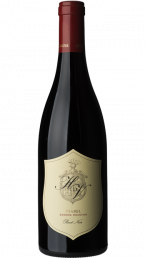
Hyde de Villaine "Ygnacia" Pinot Noir 2019
The 2019 was a super-exciting vintage because of the balance, concentration and purity of flavours centred by fresh acidity but ONLY 420 cases were produced of the mind-blowing pinot! Luckily for Dhall & Nash, we have a small allocation for our dedicated customers. However, do Not delay or you’ll be very very disappointed ☹
94 points OLots of violets, roses, and hibiscus with some dried strawberry on the nose. Full-bodied with smoky, smooth tannins and lovely balance and freshness. Hints of smoked meat to the fruit. Firm and bright.
94 points – James Suckling
94 points “Wonderfully rendered, with a lush and inviting wave of griotte, plum puree and raspberry coulis notes that stretch out, while notes of anise, wood spice and red tea fill in. The sleek mineral underpinning adds subtle contrast to the very expressive fruit. Lovely.”
94 points – Wine Spectator, James Molesworth
“Hyde Vineyard in Carneros has a track record for outstanding Pinot Noir”
James Molesworth, Wine Spectator
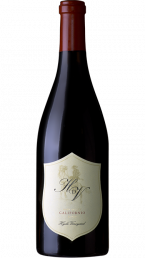
Hyde de Villaine "Californio" Syrah 2017
The HdV Californio Syrah is a programme they initiated in 2002, produced from 3 heirloom clone selections planted in the cool climate of the Hyde vineyard.
The term “Californio” is a reverential salute to the Spanish speaking settlers of Las Californias, including many of the Hyde’s family ancestors, during the periods of Spanish and Mexican California, between 1683 and 1848.
95 points “Silky tannins add to its sheer appeal. Dark blue/purplish fruit, spice, licorice, and menthol are some of the many notes that open in the glass. This distinctly Pinot-leaning Syrah delivers the goods.”
95 points – Antonio Galloni, Vinous
94 points “Meat and spice with some pepper and fresh herbs. Tea leaf and tobacco, too. Attractive dark fruit. Raspberries, some blackberries and orange zest. Medium-to full-bodied with round, tight tannins, and a fine finish. Shows pretty texture.”
94 points – James Suckling
Antonio Galloni of Vinous recently called the 2018 HdV Californio Syrah “One of the finest syrahs I’ve ever tasted, a flat-out stunner!”
Winery Tasting Notes “Rich strawberry and rhubarb aromas delicately interweave with layers of rose hips, steeped Oolong tea and anise. An herbal, almost minty sensation, leads into tones of pie crust and pomegranate. The concentration of this vintage also brings a darker, brooding character while still providing velvety tannins and fresh acidity.”
Guillaume Boudet, Winemaker
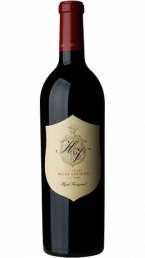
Hyde de Villaine "Belle Cousine" 2017
The Hyde de Villaine Belle Cousine is a Merlot and Cabernet Sauvignon blend from 22-year-old vines planted on the eastern edge of the Carneros District. Its name is a reference to Pamela Fairbanks de Villaine, Larry Hyde’s “belle cousine”.
93 points “It is bold but also rustic, with brawny tannins that add to an impression of wildness. Dark fruit, tobacco, chocolate, spice, and strong savory accents fill out the layers.”
93 points – Antonio Gallonig, Vinous
94 points “Aromas of blackcurrants and sweet tobacco with some dried earth. Hints of dried herbs, too. Medium-to full-bodied with black olive and blueberry and hints of firm, chewy tannins. Fresh and juicy finish.”
94 points – James Suckling
Here at D&N we have a continued and totally understandable infatuation with American fine wines and HdV deservedly sits on the throne at the top of our list.
Although this is neither a fabled Grand Cru, nor are they “unicorn wines”, the HdV wines are highly covetable, but with Strictly Limited availability!
They are extremely age-worthy wines of total purity and gobsmacking majesty – across the whole range! Act fast, pick up the phone, grab your laptop, and order now to guarantee you secure some of these precious liquid jewels of true Californian class… Hyde De Villaine par excellence!
“Because of his ‘other’ project he’s [Aubert de Villaine] never been interested in making DRC West”
James Eyer, General Manager at HdV
